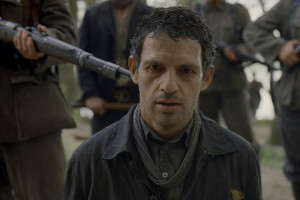 Review: Limited Run
Review: Limited Run
Son of Saul | Lázló Nemes | Hungary | 2015 | 107 minutes
Now Playing at Sundance Cinemas through Thursday, March 10»
James Kreul argues that Son of Saul works best when a single minded quest for simple dignity provides a distinct perspective on the Holocaust.
Son of Saul has been on our radar at Madison Film Forum since we started working on the Missed Madison Film Festival, when it appeared on many Best of 2015 lists, but with its late nationwide distribution it seemed likely it would eventually appear in local theaters. As a Oscar nominee for Best Foreign Language film, it joins other nominees Mustang and Embrace of the Serpent as films that Madison audiences can catch up on in early 2016. (As Rob Thomas has pointed out, Madison is also lucky to have access to a 35mm print at Sundance this week.)
As much as I liked Mustang, I agree with the prevailing opinion that Son of Saul will likely win the Oscar tonight. I was not surprised by any of the plot developments in Son of Saul, but I was surprised how compelling I found its focus on the limited perspective of Sonderkommando Saul Ausländer (Géza Röhrig) as he audaciously attempts to preserve the dignity of a gas chamber victim by securing a proper burial for him. Saul claims that the young victim is his son, which takes on a poetic truth regardless of the young boy’s actual identity. The fact that this simple quest for dignity makes no sense to Saul’s captive work detail colleagues makes the scenario even more horrifying.
Son of Saul joins 2015 winner Ida as a film that attempts to defamiliarize us from our expectations for oft-told Holocaust dramas through fresh perspectives and unconventional stylistic decisions. Like Ida, Son of Saul was shot in Academy ratio, which in this case often limits our field of view during frequent close ups of Saul. But while Ida featured pristine black-and-white imagery with unconventional and striking deep focus compositions, in Son of Saul shallow focus hand-held shots often barely allow us to see action in the mid-ground and background. The effect is quite unsettling. We know what we would see if we could, and the fact that everyone we do see treats the horror around them so matter-of-factly is completely horrifying.
We spend a lot of time looking at Saul’s face. While not expressionless, the consistency of Röhrig’s facial expression leads us to project a range of thoughts and emotions on Saul. He can’t possibly not react to what he sees, one would think, so we must react for him. But Saul’s body and soul has been battered by what he has seen and done to stay alive, and one key to survival is to keep his head and eyes down and remain unnoticed. Several key plot points depend on the fact that no one seems to even notice Saul when he’s not where he’s supposed to be. When Saul’s expression does change (especially some key moments near the end), it carries a great deal of emotional weight, even when we’re not exactly sure what he’s thinking or feeling.
It’s hard to say which is more disturbing: not being able to see the controlled routine of the gas chambers or not being able to see the chaotic mass-grave executions when they are out of focus in the background. The claustrophobic extended takes of Saul’s work routine reminded me of another Eastern European tour of horrifying bureaucracy: Cristi Puiu’s portrait of the Romanian health care system, The Death of Mr. Lazarescu (2006). And the bleak sensibility here reminded me of Nemes’ fellow Hungarian, Bela Tarr. But the key difference from Ida, Lazarescu, Tarr is how messy Saul is; those films get their energy from their precision, Saul gets its energy from the seemingly haphazard (but technically difficult to pull off) sense of not being able to see what needs to be seen.
Son of Saul only becomes less interesting when it works a bit too hard to create opportunities for the plot to move forward, as Saul’s single minded quest gets swept up into a larger camp revolt. Saul’s quest is something we haven’t seen before and is compelling because he seems to know that even success will have negative consequences for himself and others. When a fellow camp member suggests that Saul might get them all killed, Saul responds, “We’re already dead.” Burying the boy matters to Saul because nothing else does anymore, which makes his choices alternately admirable and frustrating.
The larger revolt is something we’ve seen before, and is less compelling because it fulfills what we all want to have happened at every camp, if it were only possible. But that’s a larger problem of trying to make a comprehensible story about something that ultimately is impossible to truly comprehend.
With Son of Saul, Nemes reminds us that we have to keep trying to understand, and remember, just the same.